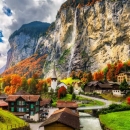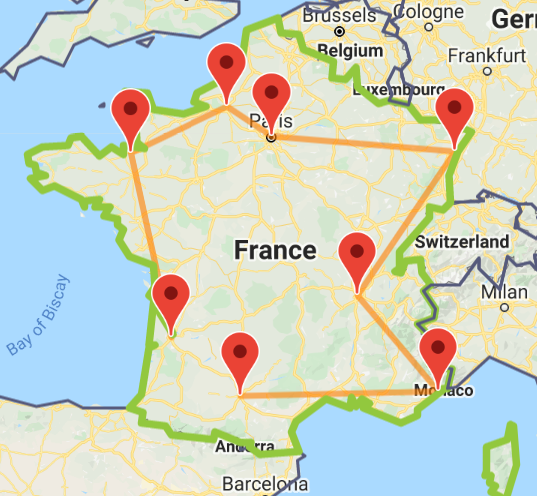
France Foodie Itinerary
From the white tablecloths of Parisian haute cuisine to the lively bouchons of Lyon, France can offer us a world of flavour. The sheer variety can even be a bit intimidating at times. If you jump right in and try whatever makes you curious, you can't go wrong.
Click here or on the map to view this route in our Trip Planner.
Cities visited in this trip:
1. Bordeaux
2. Brittany and Normandy
3. Paris
4. Strasbourg
5. Dijon
6. Lyon
7. Provence
8. Toulouse
For this itinerary, we recommend:
- Interrail Pass: France Pass
- Travel days: 8 days within 1 month
Bordeaux
If you heard your wine radar pinging, it's because we're starting things out in Bordeaux. Wherever there are copious amounts of red wine, there are bound to be some equally indulgent meat dishes to pair it with. Bordeaux is no exception.
What to eat: Entrecôte à la bordelaise. When visiting Bordeaux, this steak topped with a red wine, shallot, and butter sauce is the perfect match for the region's cabernet sauvignon and merlot-prominent wines. If you're interested in heartiness while skipping the meat, different preparations of cèpes, a local mushroom, will surely do the trick.
Local tip: A speciality that you'll find all across France is the delicious confit de canard, duck cooked in its own fat. The southwest of France is known as the birthplace of this decadent dish, so while you're in Bordeaux and the surrounding area, give it a try!
Brittany and Normandy
As you make your way up to the northwest of the country, you'll encounter quaint, historical cities and villages whose culinary focus lies in simplicity. Jam-packed with high-quality agricultural ingredients and seafood from the region, comfort food is the name of the game.
What to eat: Galettes and crêpes. Everyone knows that you can find crêpes on every street corner in Paris, but if you look for the source of these thin, versatile pancakes, you'll find that the wheat-loving region of Brittany is the best place to try countless variations of the savoury buckwheat flour galettes or sweet wheat flour crêpes. France's northwest is also a significant producer of dairy products. As such, you'll find milks, butters, creams, and cheeses enriching the fabulous food. In Normandy, you can try camembert cheese in its homeland. Finally, the close proximity to the sea makes for impressive fruits de mer, platters of fresh seafood served cold on a bed of ice.
Local tip: Many apples are grown in Brittany and Normandy, which shows in the cuisine. Many apples are destined to become beverages like ciders and calvados, an apple brandy. Both tend to play a role in local stews. Naturally, the apples also form a foundation for tasty pastries and other desserts.
Paris
For some, it's the city of light, while for others, it's the city of love. Foodies, however, will each have their own special idea of what makes Paris stand out to them. This is because Paris holds something for everyone. Casual brasseries and bistros stand just around the corner from some of the finest (and most expensive) restaurants in the world. Cafés, bakeries, and chocolatiers all line the streets. Parisians live their lives out and about, so when you make it to Paris, follow their lead.
What to eat: Everything. Choosing one or even a selection of things to eat in Paris is virtually impossible. There is simply so much good food here that we could easily write another whole guide just on food in the French capital. Paris combines traditional fine dining, regional specialities from all over the country, international influences, and modern, innovative techniques reserved for the fanciest of restaurants. One recommendation would be to avoid the regional favourites from this itinerary, no matter how tempting they may be, so you can try them in their original form. Paris is, however, a great place to try national favourites like hachis parmentier, croque monsieur, macarons, and the ubiquitous baguette.
Local tips: Start each day with a different pastry from local bakeries. Parisian bakeries can be found all over the place and feature endless variations of baguettes, croissants, pain au chocolat, éclairs, and much more.
Sit-down dinners at brasseries are a good balance between the food you can order and the price that you'll pay. Chances are you'll have access to typical Parisian fare like steak frites or onion soup. That said, don't let price deter you from a full Parisian restaurant experience. Many establishments offer a prix-fixe or "fixed-price" menu option that lets you keep within your budget while still dining out on the town among the glistening streets of Paris.
Strasbourg
Alongside the French/German border, you'll find the region of Alsace, an area that historically changed hands quite a bit, resulting in a unique hybrid that can be observed in the architecture, language, and, of course, the food.
What to eat: Flammekueche. Sometimes characterized as an Alsatian pizza, this flatbread is topped with crème fraîche, cheese, onions, and lardons. Different variations see the addition of additional ingredients like mushrooms or Gruyère cheese. Heavy appetites will appreciate the German-influenced choucroute, which contains sauerkraut and a variety of meats and sausages.
Local tips: Pastries and tarts from Strasbourg's bakeries make for exceptional breakfasts to start your day on the right foot. The neighbouring Lorraine region's quiche, a type of tart filled with eggs, vegetables, and/or meats are also worth a try. If you're particularly curious about quiche, we wouldn't blame you for taking a day trip to Metz to experience it firsthand.
While in much of France, a nice wine is the beverage of choice to accompany a meal, in Strasbourg, you'll just as easily fit in drinking one of the local beers. If you do go for wine, riesling and gewürztraminer are among the most popular.
Dijon
Dijon is the capital of Burgundy, another legendary wine region known for classic French dishes. Make a stop here on your way south to taste the richness of the rustic Burgundy home cooking. Don't forget also to try the eponymous Dijon mustard.
What to eat: Coq au vin. An internationally celebrated dish, coq au vin has its roots right here in Burgundy. Slowly simmered chicken, vegetables, and red wine come together in an irresistible combination that you can't get enough of. If you like the sound of this, you'll also surely be impressed by bœuf bourguignon, which also benefits from a slow braising technique but uses beef and different vegetables instead.
Local tip: If you're feeling brave, there's no more delicious place than Burgundy to try escargot. While the idea of eating snails may not appeal to you straight away, the traditional preparation with garlic and parsley-infused butter is nothing short of heavenly.
Lyon
Arguably one of the most foodie cities in all of France, Lyon is particularly famous for its bouchons, small, lively restaurants that serve hearty recipes once served to local silk workers. It's been the home to many famous chefs, and it's not hard to see why.
What to eat: Quenelle. A Lyonnaise fish or meat dumpling swimming in creamy sauce. This skillfully prepared dish is one that you can't leave Lyon without trying. Lyon is also fond of sausages and charcuterie, so andouillette and saucisson are also solid choices. Salade lyonnaise gives the chance to eat "light" without missing out on some of the richness.
Local tip: Check out the Les Halles de Lyon market, where you'll find a wide array of food vendors offering only the freshest ingredients. It's a certified bucket list item for any serious foodie.
Provence
As you head further south and get closer to France's Mediterranean coast, you'll quickly start to see little changes in the cuisine. Ingredients brighten up a bit. Butter is swapped for olive oil. Fish takes a more prominent role in contrast to the poultry dominance of the rest of Southern France. As soon as you see the sea, it's a sign that things are going to get tasty. Provençal cuisine can be found all throughout the region, so take your pick of where you want to stay depending on whether you're feeling the city vibes or longing for a little relaxation in a small village or seaside resort town.
What to eat: Bouillabaisse. A fish soup with at least four different types of fish/shellfish and a broth coloured by Saffron, this classic from Marseilles is guaranteed to tickle your taste buds. It's unclear whether there was ever an original consensus on which fish belong and which ones don't, but you can debate it over a glass or two of pastis, an aniseed liqueur, while you wait for it to come out.
Local tip: Eat your veggies! Make mom proud and try the vibrant ratatouille in Provence. This dish, composed of eggplants, zucchini, peppers, tomatoes, onions, garlic, and parsley, is an awesome vegetarian treat.
Toulouse
The final stop on our French Foodie Itinerary is Toulouse in the south of France. Poultry is the name of the game in Toulouse and the surrounding area, specifically duck and goose, which are used for rich, emblematic dishes like foie gras and confit de canard. In Toulouse, you'll find the epitome of comfort food.
What to eat: Cassoulet. White beans are one of the few things that everyone agrees should go into the perfect cassoulet. Aside from that, and the traditional earthenware pan that gives it its name, there's a lot up for discussion. In Toulouse, duck confit and Toulouse sausage make the dish stand out, but you can find other variations with pork, goose, and/or mutton. To get the full experience, visit the whole "Cassoulet Belt" of Toulouse, Castelnaudary, and Carcassonne and see for yourself which variation you think is best!
Local tip: If you need to satisfy your sweet tooth, le fénétra, a mouth-watering cake made with apricots, lemon, and almonds is a very local and very tasty solution.
Start dreaming about your foodie adventures
You could spend a lifetime uncovering the great culinary secrets of Europe, so now is as good a time as any to start dreaming. Check out our Ultimate Foodie Itinerary as a solid foundation for foodie must-eats. As they say in France, Bon appétit!
Change of currency
You cannot change the currency once you have a Pass in your cart. Remove the Pass, and then change the currency on the website header.






